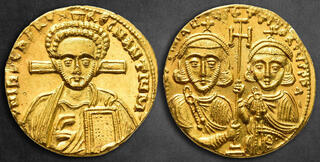Lot description:
Justinian II, 2nd reign AD 705-711. Constantinople
Solidus AV
20 mm, 4,51 g
d N IhS ChS RЄX-RЄGNANTIЧM, facing bust of youthful Christ Pantocrator, with slight beard and tight, curly hair, right hand raised in benediction, book of gospels cradled in left arm; cross behind / d N IЧSTINIA-NЧS ЄT TIbЄRIЧS PP A, crowned facing half-length figures of Justinian II (on left), bearded, and Tiberius (on right), smaller and beardless, both wearing divitision, chlamys, and crown surmounted by cross, jointly holding cross potent on two steps.
Few contact marks, otherwise, Mint State.
Sear 1414.
The second reign of Justinian II, known as Rhinotmetus (the Slit-nosed), marked a tumultuous period in Byzantine history, characterized by his unlikely return to power and the co-reign with Tiberius III. After his initial deposition in 695 due to unpopular and harsh rule, Justinian II was exiled and subjected to mutilation, a common practice to prevent deposed rulers from reclaiming the throne. However, his resilience and determination led to an extraordinary comeback. In 705, with the help of Bulgar and Slav allies, Justinian II managed to reclaim the Byzantine throne, showcasing a rare instance of a Byzantine emperor regaining power after such a downfall. Upon his return, Justinian's rule was marked by a thirst for revenge against those who had wronged him and an attempt to restore his authority and the sanctity of the imperial office. During this second tenure, Justinian II's co-reign with Tiberius III was brief and fraught with challenges. Tiberius, initially a usurper who took advantage of Justinian's absence, was quickly sidelined as Justinian II sought to consolidate power solely under his control. The co-reign essentially highlighted the complexities of Byzantine politics, where alliances and power dynamics were constantly in flux. Justinian II's efforts to restore stability and his previous policies were overshadowed by his vengeful actions, which ultimately contributed to his unpopularity and the instability of his reign. His second rule came to an abrupt end in 711 when he was overthrown once more and executed, closing the chapter on one of the most dramatic and turbulent reigns in the history of the Byzantine Empire. This period underscores the volatile nature of Byzantine imperial politics and the remarkable story of a ruler's fall, exile, and brief restoration to power.
Starting price: 2500 EUR |  |